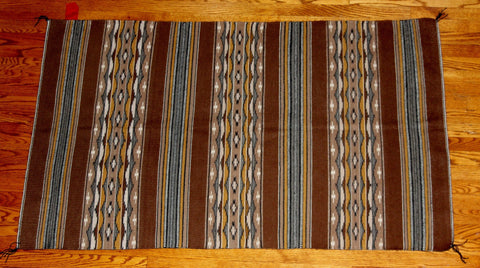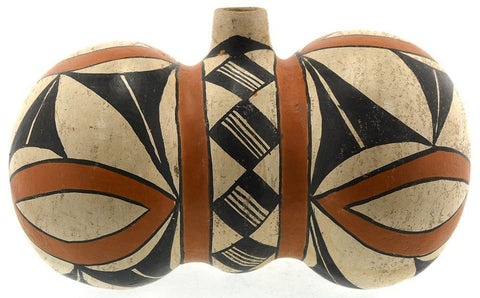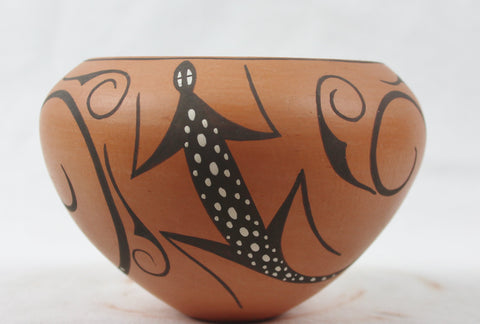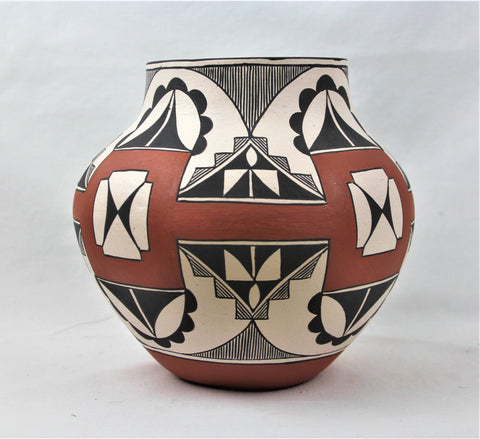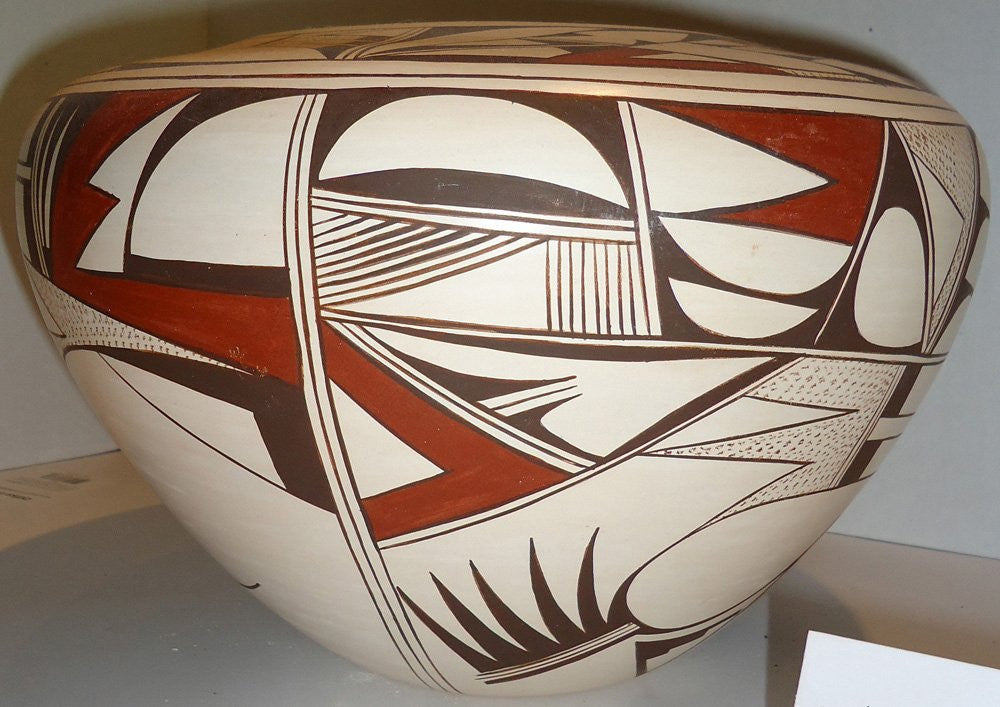
Native American Hopi Poly-chrome Pottery pot by Joy Navasie, #849 Sold
$ 2,518.75
Native American
Hopi Poly-chrome Pottery Pot by Joy Navasie
849. Description: Native American Hopi Poly-chrome Pottery pot by Joy Navasie. Three color, geometric pattern; signed with Frog Woman symbol (Joy Navasie).
Dimensions: H-7 1/2", Dia.-11".
Condition: Excellent condition.
-------------
The most famous living Navasie potter is Joy. Joy Navasie is the daughter of Paqua Naha. She uses a frog as her mark (like her mother did late in her life). Frog Woman makes her pottery in the old way. The clay process, paints, slip, and firing is entirely her work. All her materials are are gathered from the Hopi Reservation. Nothing is bought or commercially manufactured.
(Source: Pueblo Pottery.net)
Hopi Pottery by Joy Navasie (1919 – 2012). Joy Navasie is among the most famous and prolific Hopi-Tewa potters. She is known as “Frog Woman”. This name was also carried by her mother, famous and innovative pottery artist Paqua Naha. Her mother taught her Hopi traditions and pottery making. Joy Navasie began her career around 1935, and she began signing her pottery with a Frog Hallmark around 1939 or 1940. Paqua Naha signed her pottery with a frog having toes; but Joy Navasie used a frog with webbed feet. Joy most often created works in the black and red on white slip style pottery. Many credit her mother, Paqua Naha, with developing white ware pottery in the early 1950’s.
Joy (originally Yellow Flower) "Frogwoman" Navasie, member of the Kachina Clan, was born in 1919 into the Hopi/Tewa Reservation. She is the daughter of the famous Paqua (original Frogwoman) Naha, who was credited for originating the white slip elegant styled Hopi pottery. Paqua’s trademark was the frog symbol and it was passed down to Joy in 1939. Joy’s frog symbol has long webbed feet while Paqua’s had short toes. Joy has been using her trademark since the age of 20. Joy is one of the most prolific and finest Hopi potters of today. She learned the traditional methods of pottery making from her mother.
Joy specializes in traditional style white slip Hopi pottery. All of the steps used to make her pottery are taught the traditional way, from gathering clay, cleaning, molding, coiling the pottery, slipping, polishing, painting and finally, outdoor firing. Joy coils many shapes of pottery, such as wedding vases, jars and bowls. Joy has shared her pottery knowledge with family members so they may continue the tradition which her mother, Paqua, started back in 1935. Joy signs her pottery with a frog symbol.
Joy is related to many famous artists including: Burel Naha, Stetson Setalla (nephews), Sylvia Naha, Fawn Navasie (nieces), Marianne Harrison, Loretta Navasie (daughters) and Charles Navasie (grandson). (Source: Cameron Trading Post)
--------
A History of Pueblo Pottery:
“Pueblo pottery is made using a coiled technique that came into northern Arizona and New Mexico from the south, some 1500 years ago. In the four-corners region of the US, nineteen pueblos and villages have historically produced pottery. Although each of these pueblos use similar traditional methods of coiling, shaping, finishing and firing, the pottery from each is distinctive.
Various clay's gathered from each pueblo’s local sources produce pottery colors that range from buff to earthy yellows, oranges, and reds, as well as black. Fired pots are sometimes left plain and other times decorated—most frequently with paint and occasionally with appliqué. Painted designs vary from pueblo to pueblo, yet share an ancient iconography based on abstract representations of clouds, rain, feathers, birds, plants, animals and other natural world features.
Tempering materials and paints, also from natural sources, contribute further to the distinctiveness of each pueblo’s pottery. Some paints are derived from plants, others from minerals. Before firing, potters in some pueblos apply a light colored slip to their pottery, which creates a bright background for painted designs or simply a lighter color plain ware vessel. Designs are painted on before firing, traditionally with a brush fashioned from yucca fiber.
Different combinations of paint color, clay color, and slips are characteristic of different pueblos. Among them are black on cream, black on buff, black on red, dark brown and dark red on white (as found in Zuni pottery), matte red on red, and polychrome—a number of natural colors on one vessel (most typically associated with Hopi). Pueblo potters also produce undecorated polished black ware, black on black ware, and carved red and carved black wares.
Making pueblo pottery is a time-consuming effort that includes gathering and preparing the clay, building and shaping the coiled pot, gathering plants to make the colored dyes, constructing yucca brushes, and, often, making a clay slip. While some Pueblo artists fire in kilns, most still fire in the traditional way in an outside fire pit, covering their vessels with large potsherds and dried sheep dung. Pottery is left to bake for many hours, producing a high-fired result.
Today, Pueblo potters continue to honor this centuries-old tradition of hand-coiled pottery production, yet value the need for contemporary artistic expression as well. They continue to improve their style, methods and designs, often combining traditional and contemporary techniques to create striking new works of art.” (Source: Museum of Northern Arizona)
----------
View the other items in my shop: http://www.etsy.com/shop/CulturalPatina?ref=shopsection_shophome_leftnav
Hopi Poly-chrome Pottery Pot by Joy Navasie
849. Description: Native American Hopi Poly-chrome Pottery pot by Joy Navasie. Three color, geometric pattern; signed with Frog Woman symbol (Joy Navasie).
Dimensions: H-7 1/2", Dia.-11".
Condition: Excellent condition.
-------------
The most famous living Navasie potter is Joy. Joy Navasie is the daughter of Paqua Naha. She uses a frog as her mark (like her mother did late in her life). Frog Woman makes her pottery in the old way. The clay process, paints, slip, and firing is entirely her work. All her materials are are gathered from the Hopi Reservation. Nothing is bought or commercially manufactured.
(Source: Pueblo Pottery.net)
Hopi Pottery by Joy Navasie (1919 – 2012). Joy Navasie is among the most famous and prolific Hopi-Tewa potters. She is known as “Frog Woman”. This name was also carried by her mother, famous and innovative pottery artist Paqua Naha. Her mother taught her Hopi traditions and pottery making. Joy Navasie began her career around 1935, and she began signing her pottery with a Frog Hallmark around 1939 or 1940. Paqua Naha signed her pottery with a frog having toes; but Joy Navasie used a frog with webbed feet. Joy most often created works in the black and red on white slip style pottery. Many credit her mother, Paqua Naha, with developing white ware pottery in the early 1950’s.
Joy (originally Yellow Flower) "Frogwoman" Navasie, member of the Kachina Clan, was born in 1919 into the Hopi/Tewa Reservation. She is the daughter of the famous Paqua (original Frogwoman) Naha, who was credited for originating the white slip elegant styled Hopi pottery. Paqua’s trademark was the frog symbol and it was passed down to Joy in 1939. Joy’s frog symbol has long webbed feet while Paqua’s had short toes. Joy has been using her trademark since the age of 20. Joy is one of the most prolific and finest Hopi potters of today. She learned the traditional methods of pottery making from her mother.
Joy specializes in traditional style white slip Hopi pottery. All of the steps used to make her pottery are taught the traditional way, from gathering clay, cleaning, molding, coiling the pottery, slipping, polishing, painting and finally, outdoor firing. Joy coils many shapes of pottery, such as wedding vases, jars and bowls. Joy has shared her pottery knowledge with family members so they may continue the tradition which her mother, Paqua, started back in 1935. Joy signs her pottery with a frog symbol.
Joy is related to many famous artists including: Burel Naha, Stetson Setalla (nephews), Sylvia Naha, Fawn Navasie (nieces), Marianne Harrison, Loretta Navasie (daughters) and Charles Navasie (grandson). (Source: Cameron Trading Post)
--------
A History of Pueblo Pottery:
“Pueblo pottery is made using a coiled technique that came into northern Arizona and New Mexico from the south, some 1500 years ago. In the four-corners region of the US, nineteen pueblos and villages have historically produced pottery. Although each of these pueblos use similar traditional methods of coiling, shaping, finishing and firing, the pottery from each is distinctive.
Various clay's gathered from each pueblo’s local sources produce pottery colors that range from buff to earthy yellows, oranges, and reds, as well as black. Fired pots are sometimes left plain and other times decorated—most frequently with paint and occasionally with appliqué. Painted designs vary from pueblo to pueblo, yet share an ancient iconography based on abstract representations of clouds, rain, feathers, birds, plants, animals and other natural world features.
Tempering materials and paints, also from natural sources, contribute further to the distinctiveness of each pueblo’s pottery. Some paints are derived from plants, others from minerals. Before firing, potters in some pueblos apply a light colored slip to their pottery, which creates a bright background for painted designs or simply a lighter color plain ware vessel. Designs are painted on before firing, traditionally with a brush fashioned from yucca fiber.
Different combinations of paint color, clay color, and slips are characteristic of different pueblos. Among them are black on cream, black on buff, black on red, dark brown and dark red on white (as found in Zuni pottery), matte red on red, and polychrome—a number of natural colors on one vessel (most typically associated with Hopi). Pueblo potters also produce undecorated polished black ware, black on black ware, and carved red and carved black wares.
Making pueblo pottery is a time-consuming effort that includes gathering and preparing the clay, building and shaping the coiled pot, gathering plants to make the colored dyes, constructing yucca brushes, and, often, making a clay slip. While some Pueblo artists fire in kilns, most still fire in the traditional way in an outside fire pit, covering their vessels with large potsherds and dried sheep dung. Pottery is left to bake for many hours, producing a high-fired result.
Today, Pueblo potters continue to honor this centuries-old tradition of hand-coiled pottery production, yet value the need for contemporary artistic expression as well. They continue to improve their style, methods and designs, often combining traditional and contemporary techniques to create striking new works of art.” (Source: Museum of Northern Arizona)
----------
View the other items in my shop: http://www.etsy.com/shop/CulturalPatina?ref=shopsection_shophome_leftnav
Related Products
Sold out
Sold out
Sold out




